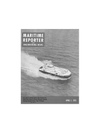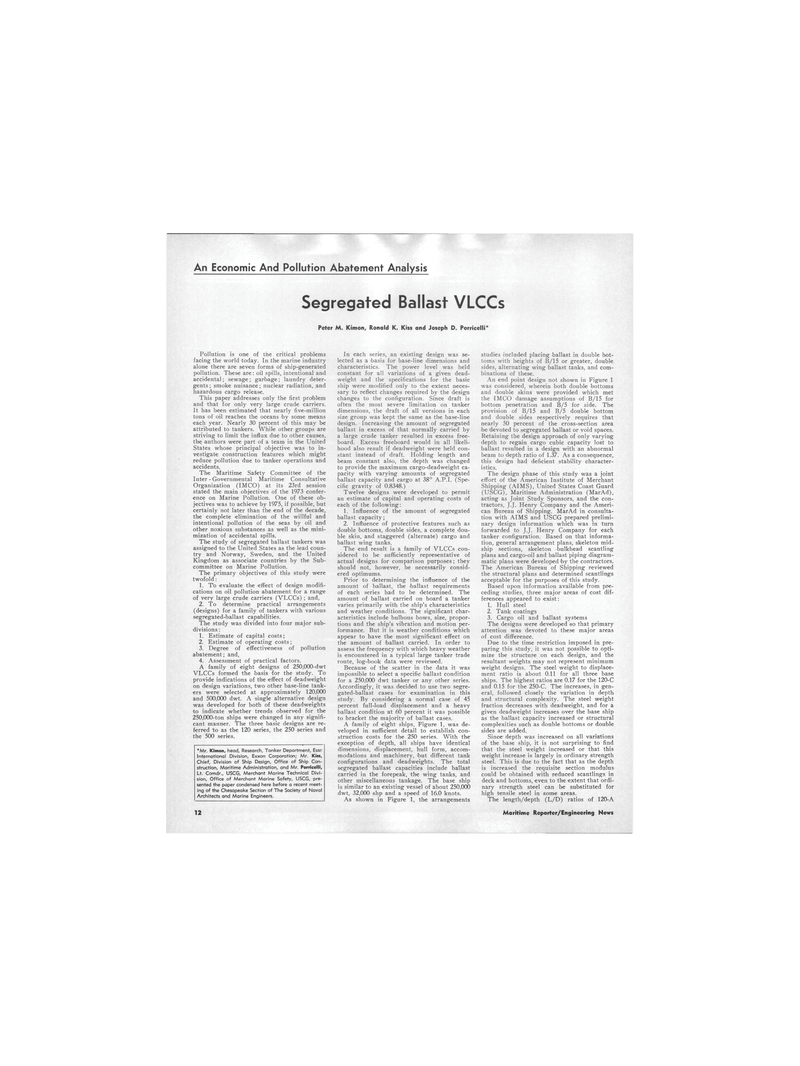
Page 10: of Maritime Reporter Magazine (April 1973)
Read this page in Pdf, Flash or Html5 edition of April 1973 Maritime Reporter Magazine
An Economic And Pollution Abatement Analysis
Segregated Ballast VLCCs
Peter M. Kimon, Ronald K. Kiss and Joseph D. Porricelli*
Pollution is one of the critical problems facing the world today. In the marine industry alone there are seven forms of ship-generated pollution. These are: oil spills, intentional and accidental; sewage ; garbage ; laundry deter- gents ; smoke nuisance; nuclear radiation, and hazardous cargo release.
This paper addresses only the first problem and that for only very large crude carriers.
It has been estimated that nearly five-million tons of oil reaches the oceans by some means each year. Nearly 30 percent of this may be attributed to tankers. While other groups are striving to limit the influx due to other causes, the authors were part of a team in the United
States whose principal objective was to in- vestigate construction features which might reduce pollution due to tanker operations and accidents.
The Maritime Safety Committee of the
Inter - Governmental Maritime Consultative
Organization (IMCO) at its 23rd session stated the main objectives of the 1973 confer- ence on Marine Pollution. One of these ob- jectives was to achieve by 1975, if possible, but certainly not later than the end of the decade, the complete elimination of the willful and intentional pollution of the seas by oil and other noxious substances as well as the mini- mization of accidental spills.
The study of segregated ballast tankers was assigned to the United States as the lead coun- try and Norway, Sweden, and the United
Kingdom as associate countries by the Sub- committee on Marine Pollution.
The primary objectives of this study were twofold: 1. To evaluate the effect of design modifi- cations on oil pollution abatement for a range of very large crude carriers (VLCCs) ; and, 2. To determine practical arrangements (designs) for a family of tankers with various segregated-ballast capabilities.
The study was divided into four major sub- divisions : 1. Estimate of capital costs; 2. Estimate of operating costs; 3. Degree of effectiveness of pollution abatement; and, 4. Assessment of practical factors.
A family of eight designs of 250,000-dwt
VLCCs formed the basis for the study. To provide indications of the effect of deadweight on design variations, two other base-line tank- ers were selected at approximately 120,000 and 500,000 dwt. A single alternative design was developed for both of these deadweights to indicate whether trends observed for the 250,000-ton ships were changed in any signifi- cant manner. The three basic designs are re- ferred to as the 120 series, the 250 series and the 500 series. *Mr. Kimon, head, Research, Tanker Department, Esse
International Division, Exxon Corporation; Mr. Kiss,
Chief, Division of Ship Design, Office of Ship Con- struction, Maritime Administration, and Mr. Porricelli,
Lt. Comdr., USCG, Merchant Marine Technical Divi- sion, Office of Merchant Marine Safety, USCG, pre- sented the paper condensed here before a recent meet- ing of the Chesapeake Section of The Society of Naval
Architects and Marine Engineers.
In each series, an existing design was se- lected as a basis for base-line dimensions and characteristics. The power level was held constant for all variations of a given dead- weight and the specifications for the basic ship were modified only to the extent neces- sary to reflect changes required by the design changes to the configuration. Since draft is often the most severe limitation on tanker dimensions, the draft of all versions in each size group was kept the same as the base-line design. Increasing the amount of segregated ballast in excess of that normally carried by a large crude tanker resulted in excess free- board. Excess freeboard would in all likeli- hood also result if deadweight were held con- stant instead of draft. Holding length and beam constant also, the depth was changed to provide the maximum cargo-deadweight ca- pacity with varying amounts of segregated ballast capacity and cargo at 38° A.P.I. (Spe- cific gravity of 0.8348.)
Twelve designs were developed to permit an estimate of capital and operating costs of each of the following: 1. Influence of the amount of segregated ballast capacity; 2. Influence of protective features such as double bottoms, double sides, a complete dou- ble skin, and staggered (alternate) cargo and ballast wing tanks.
The end result is a family of VLCCs con- sidered to be sufficiently representative of actual designs for comparison purposes; they should not, however, be necessarily consid- ered optimums.
Prior to determining the influence of the amount of ballast, the ballast requirements of each series had to be determined. The amount of ballast carried on board a tanker varies primarily with the ship's characteristics and weather conditions. The significant char- acteristics include bulbous bows, size, propor- tions and the ship's vibration and motion per- formance. But it is weather conditions which appear to have the most significant effect on the amount of ballast carried. In order to assess the frequency with which heavy weather is encountered in a typical large tanker trade route, log-book data were reviewed.
Because of the scatter in the data it was impossible to select a specific ballast condition for a 250,000 dwt tanker or any other series.
Accordingly, it was decided to use two segre- gated-ballast cases for examination in this study. By considering a normal case of 45 percent full-load displacement and a heavy ballast condition at 60 percent it was possible to bracket the majority of ballast cases.
A family of eight ships, Figure 1, was de- veloped in. sufficient detail to establish con- struction costs for the 250 series. With the exception of depth, all ships have identical dimensions, displacement, hull form, accom- modations and machinery, but different tank configurations and deadweights. The total segregated ballast capacities include ballast carried in the forepeak, the wing tanks, and other miscellaneous tankage. The base ship is similar to an existing vessel of about 250,000 dwt, 32,000 shp and a speed of 16.0 knots.
As shown in Figure 1, the arrangements studies included placing ballast in double bot- toms with heights of B/15 or greater, double sides, alternating wing ballast tanks, and com- binations of these.
An end point design not shown in Figure 1 was considered, wherein both double bottoms and double skins were provided which met the IMCO damage assumptions of B/15 for bottom penetration and B/5 for side. The provision of B/15 and B/5 double bottom and double sides respectively requires that nearly 50 percent of the cross-section area be devoted to segregated ballast or void spaces.
Retaining the design approach of only varying depth to regain cargo cubic capacity lost to ballast resulted in a design with an abnormal beam to depth ratio of 1.37. As a consequence, this design had deficient stability character- istics.
The design phase of this study was a joint effort of the American Institute of Merchant
Shipping (AIMS), United States Coast Guard (USCG), Maritime Administration (MarAd), acting as Joint Study Sponsors, and the con- tractors, J.J. Henry Company and the Ameri- can Bureau of Shipping. MarAd in consulta- tion with AIMS and USCG prepared prelimi- nary design information which was in turn forwarded to J.J. Henry Company for each tanker configuration. Based on that informa- tion, general arrangement plans, skeleton mid- ship sections, skeleton bulkhead scantling plans and cargo-oil and ballast piping diagram- matic plans were developed by the contractors.
The American Bureau of Shipping reviewed the structural plans and determined scantlings acceptable for the purposes of this study.
Based upon information available from pre- ceding studies, three major areas of cost dif- ferences appeared to exist: 1. Hull steel 2. Tank coatings 3. Cargo oil and ballast systems
The designs were developed so that primary attention was devoted to these major areas of cost difference.
Due to the time restriction imposed in pre- paring this study, it was not possible to opti- mize the structure on each design, and the resultant weights may not represent minimum weight designs. The steel weight to displace- ment ratio is about 0.11 for all three base ships. The highest ratios are 0.17 for the 120-C and 0.15 for the 250-C. The increases, in gen- eral, followed closely the variation in depth and structural complexity. The steel weight fraction decreases with deadweight, and for a given deadweight increases over the base ship as the ballast capacity increased or structural complexities such as double bottoms or double sides are added.
Since depth was increased on all variations of the base ship, it is not surprising to find that the steel weight increased or that this weight increase is largely in ordinary strength steel. This is due to the fact that as the depth is increased the requisite section modulus could be obtained with reduced scantlings in deck and bottoms, even to the extent that ordi- nary strength steel can be substituted for high tensile steel in some areas.
The length/depth (L/D) ratios of 120-A 12 Maritime Reporter/Engineering News

 9
9

 11
11
